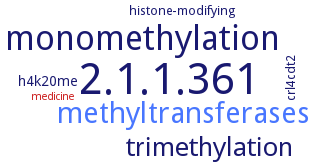2.1.1.361: [histone H4]-lysine20 N-methyltransferase
This is an abbreviated version!
For detailed information about [histone H4]-lysine20 N-methyltransferase, go to the full flat file.

Word Map on EC 2.1.1.361 
-
2.1.1.361
-
monomethylation
-
methyltransferases
-
trimethylation
-
h4k20me
-
crl4cdt2
-
histone-modifying
-
medicine
- 2.1.1.361
-
monomethylation
- methyltransferases
-
trimethylation
-
h4k20me
-
crl4cdt2
-
histone-modifying
- medicine
Reaction
Synonyms
CG3307, EC 2.1.1.43, H4-K20-specific HMT, H4-K20-specific HMTase, H4-K20-specific methyltransferase, H4K20 di- and trimethyltransferase, H4K20 methyltransferase, H4K20 protein lysine methyltransferase, histone 4 K20 methyltransferase, histone H4 Lys 20 methyltransferase, histone H4 Lys 20 monomethyltransferase, histone H4 lysine 20 methyltransferase, histone H4 lysine 20 monomethyltransferase, histone H4 lysine20 trimethyltransferase, histone H4-K20 methyltransferase, histone H4-K20 trimethyltransferase, histone H4-lysine 20-specific methyltransferase, histone lysine methyltransferase, Hmt4-20, KMT5a, PKMT, Pr-Set7, PR-Set7/9, protein lysine methyltransferase, SET-4, SET8, SETD8, Suv4-20, Suv4-20h2


 results (
results ( results (
results ( top
top





